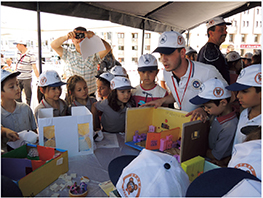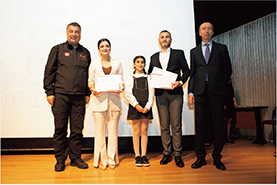Stories from the Field 02
Japan’s Efforts on Disaster Risk Reduction Education in Türkiye, an Earthquake-Prone Country
– Spreading Knowledge through the Turkish Version of “Bosai Koshien” –

School-Based Disaster Education Project (Photo: JICA)

Award ceremony for the Turkish version of “Bosai Koshien” (The person on the right in the photo is Dr. Özdamar) (Photo: JICA)
Türkiye has many active fault lines, and like Japan, it is one of the most earthquake-prone countries in the world. Türkiye has experienced large-scale earthquakes in 2011 and 2020, in addition to the Izmit earthquake in August 1999 with its epicenter in northwestern Türkiye, and the Düzce earthquake in November of the same year. In February 2023, an earthquake centered in southeastern Türkiye caused severe damage, claiming nearly 50,000 casualties. Densely populated areas including Istanbul, the center of economic development, are said to be at great risk, and further efforts are required for disaster risk reduction.
Japan, also a disaster-prone country, has utilized its experience and knowledge to provide Türkiye with yen loans to contribute to strengthening seismic reinforcement and earthquake reconstruction, promote joint research on seismic observation and earthquake engineering, and provide technical cooperation to formulate disaster risk reduction plans and improve disaster risk management capabilities. After the 1999 Izmit earthquake, efforts were put into disaster risk reduction education, and the “School-Based Disaster Education Project” was implemented in two phases from 2010 to 2014 and from 2017 to 2020. In Phase 1, Japan targeted 80 basic schools in 10 provinces with large economic scales and conducted disaster risk reduction training with three teachers from each school as master teachers. In Phase 2, activities to disseminate and expand the disaster education were carried out nationwide. Dr. Emin Özdamar, a former staff engaged in the disaster risk reduction education at the JICA Türkiye Office and currently the Vice-Chairman at the Turkish Japanese Foundation, looks back at their initial efforts and says, “With the cooperation of Hyogo Prefecture, an area affected by the Great Hanshin-Awaji Earthquake, we compared Hyogo Prefecture’s educational curriculum with Türkiye’s curriculum and incorporated parts that could be applied to Türkiye. We also worked with teachers to come up with a game so that children could learn disaster risk reduction knowledge while having fun. In addition, we worked to help children acquire knowledge naturally without being bound by the framework of disaster risk reduction, such as by incorporating disaster risk reduction content into math and other courses.”
Since the implementation of the project, master teachers who have completed their training have passed on their disaster risk reduction knowledge to teachers at other schools, trying to create an environment in which each school has at least one teacher with disaster risk reduction knowledge. Regarding the ripple effects of disaster risk reduction education, Dr. Özdamar says, “When we provide disaster risk reduction education to children, they pass on that knowledge to their families and classmates. Basic knowledge, such as placing beds in safe places and securing furniture, is being shared by trained teachers with children and their families. During the earthquake in February 2023, some teachers and students did what they had learned and crouched next to their beds to protect themselves.”
From 2021, the Turkish-Japanese Foundation Culture Center and JICA co-host the “Disaster Education Materials Development Contest” (the Turkish version of “Bosai Koshien”Note 1) in order to ensure the continuing effects of the School-Based Disaster Education Project. “When I visited Miyagi Prefectural Tagajo High School, where the Disaster Science Course was established, I learned about ‘Bosai Koshien.’ In order to spread the achievements of the School-Based Disaster Education Project, I thought we would need to involve young people, so we took action to hold a Turkish version of ‘Bosai Koshien.’” says Dr. Özdamar. The first competition was held for teachers, and the organizers received 40 entries from 21 provinces. The target audience was later expanded to include students, and in 2023, 156 applications were received from 29 provinces, including tabletop games related to disaster risk reduction and disaster risk reduction simulation devices using models. In addition, in the university student category, there were 86 projects from universities with departments related to disaster risk reduction.
However, even if people in Türkiye receive disaster risk reduction education, if they do not comply with building standards and strengthen the ground, the effectiveness of the education will be halved. Chief Representative of JICA Türkiye Office Ms. TANAKA Yuko describes the prospects as follows. “In response to the earthquake damage in February 2023, we are also reviewing disaster risk reduction cooperation in Türkiye based on the recommendations of the expert team. We will continue to cooperate in building cities that are resilient to disasters, using the disaster-stricken cities as model cities.”
Currently, through a student exchange project connecting high schools in Hyogo and Miyagi Prefectures with Turkish students, young people learn about each other’s experiences in disaster-affected areas. It is expected that the achievements of Japan in the field of disaster risk reduction will be further utilized for disaster risk reduction in Türkiye.
Note 1: This nationwide competition honors children and students who are engaged in disaster risk reduction education and activities in their schools and local communities in order to pass on the experiences and lessons learned from the Great Hanshin-Awaji Earthquake that occurred on January 17, 1995, to the future. It is held every year by the Hyogo Earthquake Memorial 21st Century Research Institute (Disaster Reduction and Human Renovation Institution), based in Kobe City.
<< Previous Page Next Page >>
Main Text | Reference Statistics | Stories from the Field | Master Techniques from Japan to the World | ODA Topics
